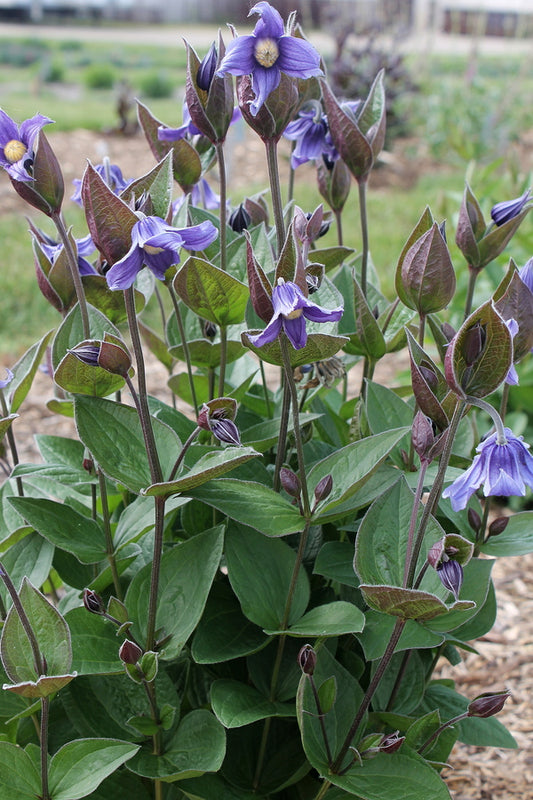Our focus is the semi-shrubby and partially-vining clematis plants. Our clematis selections feature dangling flowers that are cup-shaped or bell-shaped. The flowers attract both butterflies and hummingbirds.
-
Clematis hexapetala 'Mongolian Snowflakes'
Item #: 10603
Zones: 4a to 7b, at least
Dormancy: Winter
Height: 18" tall
Culture: Sun
Origin: China, Eastern Asia, Korea, Mongolia, Siberia Russia
Pot Size: 3.5" pot (24 fl. oz/0.7 L)
Regular price $27.00Regular priceUnit price per -
Clematis integrifolia 'Lake Baikal'
Item #: 5937
Zones: 3a to 8b
Dormancy: Winter
Height: 24" tall
Culture: Sun
Origin: Russia
Pot Size: 3.5" pot (24 fl. oz/0.7 L)
Regular price $27.00Regular priceUnit price per -
Clematis 'Rooguchi'
Item #: 7093
Zones: 3a to 8b
Dormancy: Winter
Height: 72" tall
Culture: Sun
Origin: Hybrid
Pot Size: 3.5" pot (24 fl. oz/0.7 L)
Regular price $29.00Regular priceUnit price per -
Clematis 'Sapphire Indigo' PP 17,012
Item #: 8947
Zones: 4a to 8b
Dormancy: Winter
Height: 18" tall
Culture: Sun
Origin: Hybrid
Pot Size: 3.5" pot (24 fl. oz/0.7 L)
Regular price $28.00Regular priceUnit price per -
Clematis 'Stand by Me' PP 30,556
Item #: 13500
Zones: 3b to 8b
Dormancy: Winter
Height: 36" tall
Culture: Sun
Origin: Hybrid
Pot Size: 3.5" pot (24 fl. oz/0.7 L)
Regular price $28.00Regular priceUnit price per -
Clematis villosa
Item #: 9872
Zones: 8a to 9b, guessing
Dormancy: Winter
Height: 12" tall
Culture: Part Sun to Light Shade
Origin: South Africa
Pot Size: 3.5" pot (24 fl. oz/0.7 L)
Regular price $35.00Regular priceUnit price per
More Information About Clematis
You are no doubt familiar with the typical vining mailbox clematis, so we've chosen the clematis road less traveled. Our focus is the semi-shrubby, partially-vining, and little-known clematis plants, many of which are native to the US (including North Carolina). These clematis are great as individual specimens as well as for weaving harmlessly through a shrub or small tree. We have found these native plants to be very easy to grow and have none of the disease dieback problems that can be expected with the large-flower hybrid clematis.
Our clematis selections feature dangling flowers that are cup-shaped or bell-shaped. Many of these unusual clematis vines die back to the ground each winter but reliably re-sprout the following spring and clamber back to their 6-10' height. Others form a rounded mound on the ground up to 18 inches tall. Many of the native clematis species that we sell are a common site along fencerows in Texas north to Illinois. The flowers attract both butterflies and hummingbirds.
How to grow clematis
- Sun - Full sun on the leaves, but Clematis roots prefer to be cool so shade them with other plants, mulch, stones, etc. Feet in the Shade, Face in the Sun.
- Soil - Clematis perform best with a rich soil with neutral pH (or slightly alkaline), well drained.
- Fertilizer - You'll get the most flowers if you fertilize regularly during the growing season with compost.
- Water - plenty of water, consistently applied during the growing season gives the best results. Clematis do not like yo-yo-ing between wet and dry soil.
- Pruning - There are some byzantine clematis pruning guides out there depending on if your clematis blooms on old wood or new wood, in the fall or in the spring. Keep it simple. There is a pruning window of time after they bloom. If they bloom in the summer/fall, you have a long window to prune...all the way from late fall to late winter. If they bloom in the spring, then the window is shorter and they need to be pruned before mid-summer. If you see dead stems...prune them back at any time. If Clematis get scraggly or sick, you can cut them back hard (30-50%) to rejuvenate them...at the expense of some flowers next season. But clematis rebound very nicely after a rejuvenation pruning.
- Support - The vining types like to scramble over nearby plants, which provides plenty of accidentally beautiful combinations and vignettes, but if you prefer a more ordered appearance, a small trellis with supports just 4-6 inches apart will do fine too.
Check out our many blog posts about Clematis.








